Super Bowl XIV - Los Angeles Rams vs Pittsburgh Steelers: Pregame
On the heels of the game-changing rules modifications for the 1978 season, the committee adopted additional changes, most of which were designed to make the game safer.
The Steelers and Cowboys were big favorites to return to the Super Bowl.
- The defending Super Bowl champions from Pittsburgh looked even stronger. "We've got all our first-line people back. There were no retirements," said QB Terry Bradshaw just before the regular season. "And our second-line guys are much stronger. We've got great depth." The Men of Steel would need that depth because the 22 starters were all a year older, averaging 29.
- Chuck Noll's 11th Steeler team started 4-0 on their way to a 12-4 regular season and the AFC Central Championship by one game over the Houston Oilers. Pittsburgh led the AFC in points scored (416) and tied for third in points allowed (262).
- With the Raiders missing the postseason for the second year in a row, Pitt breezed through the AFC playoffs, downing Miami 34-14 and Houston 27-13 to earn the club's fourth Super Bowl berth in the last six years.
Dallas's season started shakily. DE "Too Tall" Jones abruptly retired to pursue a pro boxing career. During the summer, star HB Tony Dorsett fell off a horse and dropped a wall mirror on his foot. As a result, he missed the first two games of the regular season
- The Cowboys finished 11-5 to tie the Philadelphia Eagles for first place in the NFC East.
- After enjoying a first round bye because of tie breakers, Dallas was upset at home by the Los Angeles Rams 21-19.
- The Rams then shut out the Tampa Bay Buccaneers, who had made the playoffs for the first time in their four years of existence.
No one foresaw the Rams reaching the Super Bowl.
- Los Angeles had been a solid team for most of the '70s, winning at least ten games every season from '73 through '78. Yet they never got over the hump and won the NFC.
- Owner Carroll Rosenbloom had drowned in April while swimming in the Atlantic Ocean. His wife Georgia inherited 70% of the Rams. As majority owner, she appointed herself president and fired Steve Rosenbloom, her stepson and a popular executive with the team who had been his father's closest advisor.
- Second-year head coach Ray Malavasi was hospitalized shortly afterward for hypertension a year after undergoing quadruple bypass surgery.
- Additionally, the club had to deal with the persistent rumors - which would prove to be correct - that the team was jettisoning the L.A. Coliseum for Anaheim the following season. To make matters worse, QB Pat Haden suffered a fractured finger on his right hand in Game 10 that ended his season. So Malavasi turned the offensive reins over to Vince Ferragamo, who had yet to start a game in his three years with the Rams.
- Finishing fifth in the NFC in both points scored and points allowed, the '79 team won four of their last five games. Their 9-7 record ended the double-digit win streak but was still good enough to edge the 8-8 New Orleans Saints for the playoff berth from the weak NFC West.
- LA won two playoff games on the road over Dallas - on Ferragamo's late 50y TD pass to Billy Waddy - and Tampa Bay to reach the Super Bowl for the first time.
Rams veteran LB Jack Youngblood recalled: "In all honesty, the Rams were probably a better football team between 1973 and 1978 than we were in 1979. We had a more dominating defense and a stronger running game."
"It was a roller coaster of a season," said Ferragamo. "First, not being expected to be in the playoffs and then making it with a 9-7 record. When I started playing mid-season, we caught fire. we were playing our best ball at the end of the season. They were total team victories with offense, defense and special teams."
Most observers believed the Steelers would have little trouble disposing of the upstart Rams. But the Pittsburgh players were far from overconfident.
Another reason the Steelers respected the Rams was the fact that Malavasi's staff included three former Pittsburgh assistants.
- Bud Carson had been the defensive coordinator from 1973-77 who designed the complicated Cover 2 zone coverage for the Steel Curtain secondary. In the same capacity with the Rams, Carson's defense limited the Steelers to 174y in a 10-7 LA victory during the 1978 season.
Carson later said, "At that point, I thought we were a better defense than Pittsburgh. L.A. was a good football team, it really was. Dallas kept them from going to the Super Bowl a lot of years."
LB Jim Youngblood recalled, "Bud came in the first day after we beat Tampa and he was all fired up. He said, 'We can beat them. I know we can beat them. We've done it before with the same personnel. We can beat them.' Once we started watching films of the Steelers, I knew we could beat them, too."
- Dan Radakovich coached Noll's offensive line from 1974-77.
- Rams offensive coordinator Lionel Taylor coached the Pittsburgh wide receivers from 1970-76.
Banaszak: "It takes great talent to get to that position (the Super Bowl). If you try to underestimate anybody, then you're a fool. A few of our old assistant coaches were with the Rams, so we knew they were going to be well coached. They had some great players, especially on their defensive line. ... They knew us probably better than any other opponent we could have faced in that game. They knew our personnel because of the coaches, and we knew going in it was going to be a tough game."
- The Rams knew the Steelers wouldn't take them lightly but used the blowout predictions of the media as motivation.
"We were heavy underdogs but that worked to our advantage," recalled Ferragamo. "We were given no respect, but people who knew us thought different. That gave us more incentive and fired us up, especially the veteran players we had on our team."
While the Super Bowl was almost old hat for the Steelers, some Rams were disappointed they were playing in their own back yard.
- The Rose Bowl in Pasadena was only 13.9 miles from the Los Angeles Coliseum where the Rams played their home games.
- DE Jack Youngblood, the Rams captain, recalled, "I'd gone to different Super Bowls as an observer and I'd been to Miami and New Orleans and all the other places, and then the year I finally get to go as a player, I don't get to go anyplace."
- On the bright side, more L.A. fans could attend without spending a small fortune on travel and lodging. The Steelers regarded Super Bowl XIV as a Rams home game - another reason to be wary of the NFC champs.
- Following NFL protocol, eight days before the game the Rams moved into the hotel in Orange County that had been booked for the NFC champions. Youngblood saw the wisdom of the move. "We could kind of stay away from all the hoopla surrounding the game and all those other distractions. ... We were a veteran team and went about trying to make it business as usual."
- The night before the game, the Rams transferred to a new Hyatt Regency in downtown Los Angeles.
The Steelers flew to California as 11-point favorites.
- Many reporters focused their articles on the Steelers' quest for sports immortality. A sample: "They are now chasing legends. The Pittsburgh Steelers enter their fourth Super Bowl with the official foe listed as the Los Angeles Rams. But the Steelers find the shadow of Vince Lombardi hanging over this Super Bowl. The name of Lombardi, the late, legendary Green Bay Packer coach, is stamped on the gleaming Super Bowl trophies. The Steelers already have three of them in a glass case in their lobby. They're heavily favored to become the first team to win four of them. If they beat the Rams, they'll become only the second team since the modern era began after World War II to win four championships in six years. That team was Lombardi's Packers, who won five times in seven years in the 1960s ..."
- The chance to make history was on the minds of the Steelers. "Five championships ... five championships," repeated DT Joe Greene. "That is something special."
- Coach Noll insisted his club was not taking the Rams lightly. He was an assistant coach under Don Shula at Baltimore for Super Bowl III when Joe Namath's New York Jets upset the heavily-favored Colts. Chuck said the Rams compared favorably to the two Dallas teams and the Minnesota club that the Steelers defeated in their first three Super Bowl games. "They have a very capable defense, and they have the offensive weapons that can produce the big play. When you have two defensive teams on the field, the penchant for the big play can separate them." That prediction would prove to be on the mark.
- Noll said his men enjoyed the Super Bowl scene. "Our team responds well to big games. We have the kind of people who get excited by big games."
- However, some Steelers felt the pressure of living up to expectations. LB Robin Cole recalled: "We were the team that was expected to win. Of course, the Rams wanted to win the game, but the pressure to win was on the Steelers, not the Rams." Greene agreed. "They're a team with nothing to lose. The 12-4 (record) we had this year, the 9-7 they had. That doesn't matter any more. The only tangible thing is winning the damn football game."
One reporter wrote that Rams coach Ray Malavasi "looks more like a friendly bartender than a football coach."
- Perhaps no one was more surprised at reaching football's pinnacle than the 24-year coaching veteran. After all, he was one loss from being fired when the Rams came to life in late November and steamed through the playoffs to the NFC title.
- But that wasn't enough to satisfy the former defensive coordinator. He told the press a week before the game: "Just to be satisfied with getting to the Super Bowl," said Malavasi, "is crazy. Winning it is what's important. That's what I've been telling our people all along. I'll tell you this. I'm comfortable right now, a lot more so than I was back when we were 6-5 and had everyone hurting."
- He recognized the Steelers had great personnel and excellent coaching. But he proclaimed, "If I could bet, I'd bet on us. We've had very good practices all week. ... I think our players are aware of what it will take to get the job done."
- Ray respected Noll but added, "No, I don't think he has an advantage over me. I've been coaching as long as he has, maybe even longer. And our team is not as bad as some people have made it out to be, and I seriously doubt whether Pittsburgh is as good as they're made out to be. All that will be resolved Sunday, though, so there's no point in arguing about it now."
- While not revealing an iota of the game plan his staff had developed with the aid of the three former Steeler assistants, Malavasi said, "We've run the ball on every team we've played. ... If we move the ball, we've got a good chance to win. And as I said, I think we've got a good chance to win the game."
The news media highlighted the contrast in QBs.
- Terry Bradshaw: age 31, ninth year in the NFL, 118 starts including three Super Bowls, MVP of Super Bowl XIII
Vince Ferragamo:
age 25, third year in the NFL, 4 starts including two playoff games
- A native of the Los Angeles area, Ferragamo had the dubious distinction of being the Super Bowl starting QB with the least experience. He agreed that the Steelers enjoyed an edge at QB. "That's a fact. That's a fair way to describe it." But Vince showed his confidence by telling a reporter that he considered himself the #1 Rams QB on merit even though Pat Haden's injured pinky had healed. Asked if he had a prediction for the game like Joe Namath, Vince replied, "I won't make a prediction, but I think we'll be on top when the game is over."
Teammates called Ferragamo a "space cadet" (absent-minded). In a late season game against the 49ers, Malavasi told him what play to run. Then Vince trotted into the huddle and called a completely different one. "Vince is a smart guy," said Ram receiver Preston Dennard. "But there are times when you've got to ask him about some things." Bradshaw could sympathize since he had been labeled dumb in the early years of his career. Vince made the Big Eight All-Academic team with a 3.6 GPA at Nebraska and was accepted to medical school.
- Bradshaw talked to reporters about his Rams counterpart. "I think if he finds out he's in the Super Bowl, he'll get scared to death. I know. I went through it." Terry sent a message to Ferragamo via former Redskins QB Sonny Jurgenson. "He told me to just keep calm and take it like any other game," Ferragamo said. "He didn't need to do that. I realize where I am. This is what the game is all about. If you don't enjoy the big games, there's no sense in playing."
Both sides dealt with injury issues.
Two players, one in each locker room, had special challenges as they prepared for the game.
- Youngblood had a unique way of preparing for the game. "My leg was taped and we had built ourselves a special stirrup-like brace that was supposed to keep the fibula from moving more than it normally did. I wasn't taking any shots or painkillers - there wasn't any way that was going to take away a broken leg."
- Terry Bradshaw slept only three hours the night before the game - midnight to 3 a.m. He averaged less than five hours of sleep for the whole week. He just couldn't shake the feeling. The Steelers were going to lose. "It was weird. It just wasn't like me, not being able to sleep before a big game. Last year before Dallas I didn't have any trouble. I never had any negative thoughts. I never think about losing. I had to say to myself, 'Stop that now. Think positive. Finally, it worked." Would sleep deprivation affect his play?
CBS televised the game with Pat Summerall and Tom Brookshier announcing.
- A 30-second commercial cost $222,000, up $37,000 from the year before.
- The game drew an estimated 76.2 million viewers, an increase of 2.5 million from Super Bowl XIII.
- Actress Cheryl Ladd sang the National Anthem.
- The NFL honored Pittsburgh owner Art Rooney by asking him to flip the coin.
The Super Bowl record crowd of 103,985 was split about 50/50 between the two fan bases. The Steeler fans waved their Terrible Towels throughout the contest. The temperature was 67° at kickoff.
|
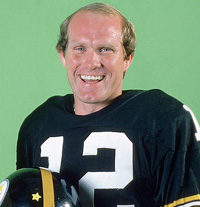 Terry Bradshaw
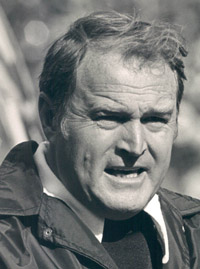
Chuck Noll
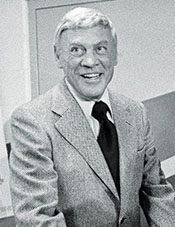
Carroll Rosenbloom
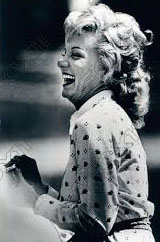
Georgia Rosenbloom
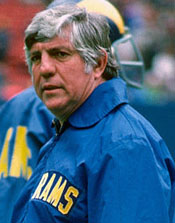
Ray Malavasi
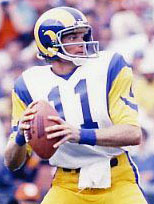
Pat Haden
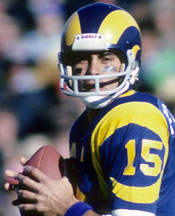
Vince Ferragamo
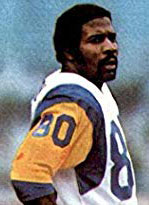
Billy Waddy
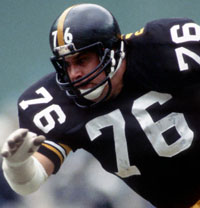
John Banaszak
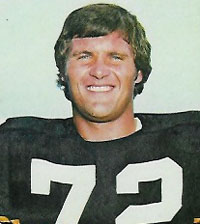
Gerry Mullins
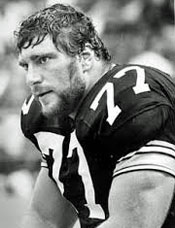
Steve Courson
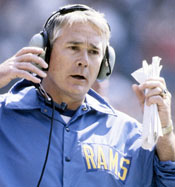
Bud Carson
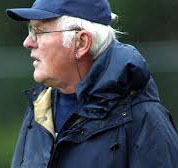
Dan Radakovich in his later years
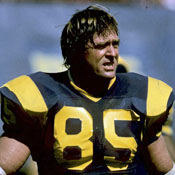
Jack Youngblood
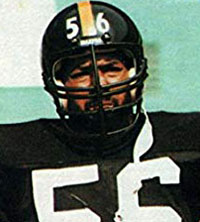
Robin Cole
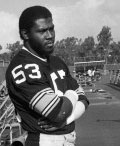
Dennis Winston
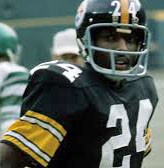
J. T. Thomas
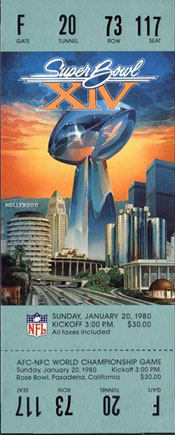
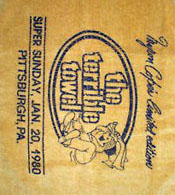
|
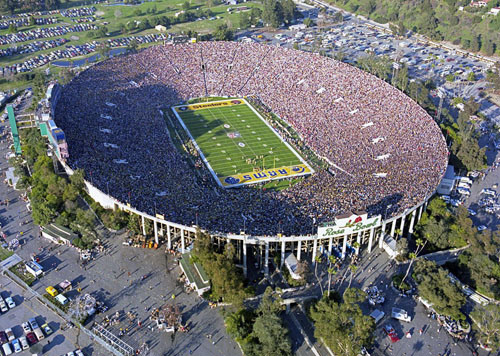 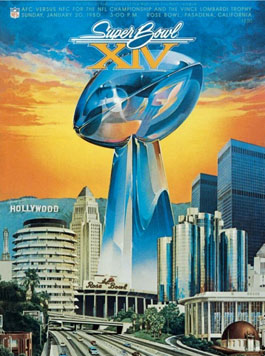
1979 Los Angeles Rams
| # |
Player |
Pos. |
Hgt. |
Wgt. |
College |
Exp. |
| 3 |
Frank Corral |
K |
6-2 |
225 |
UCLA |
2 |
| 8 |
Jeff Rutledge |
QB |
6-1 |
195 |
Alababma |
1 |
| 13 |
Ken Clark |
P |
6-2 |
195 |
St. Mary's (Canada) |
1 |
| 15 |
Vince Ferragamo |
QB |
6-3 |
205 |
California, Nebraska |
3 |
| 19 |
Bob Lee |
QB |
6-2 |
195 |
Arizona St., Pacific |
11 |
| 20 |
Jackie Wallace |
S |
6-3 |
195 |
Arizona |
6 |
| 21 |
Nolan Cromwell |
S |
6-1 |
195 |
Kansas |
3 |
| 24 |
Eddie Hill |
RB |
6-2 |
205 |
Memphis |
1 |
| 25 |
Eddie Brown |
S |
5-11 |
185 |
Tennessee |
6 |
| 26 |
Wendell Tyler |
RB |
5-10 |
190 |
UCLA |
3 |
| 27 |
Pat Thomas |
CB |
5-9 |
185 |
Texas A&M |
4 |
| 28 |
Ken Ellis |
CB |
5-10 |
190 |
Southern |
10 |
| 30 |
Lawrence McCutcheon |
RB |
6-1 |
205 |
Colorado State |
8 |
| 32 |
Cullen Bryant |
RB |
6-1 |
235 |
Colorado |
7 |
| 33 |
Dwayne O'Steen |
CB |
6-1 |
195 |
California, San Jose St. |
2 |
| 37 |
Ivory Sully |
CB |
6-0 |
200 |
Delaware |
1 |
| 42 |
Dave Elmendorf |
S |
6-1 |
195 |
Texas A&M |
9 |
| 43 |
Jim Jodat |
RB |
5-11 |
210 |
Carthage |
3 |
| 49 |
Rod Perry |
CB |
5-9 |
175 |
Colorado |
5 |
| 51 |
Joe Harris |
LB |
6-1 |
225 |
Georgia Tech |
3 |
| 52 |
George Andrews |
LB |
6-3 |
225 |
Nebraska |
1 |
| 53 |
Jim Youngblood |
LB |
6-3 |
230 |
Tennessee Tech |
7 |
| 54 |
Dan Ryczek |
C |
6-3 |
250 |
Virginia |
7 |
| 57 |
Greg Westbrooks |
LB |
6-2 |
215 |
Mesa, Colorado |
5 |
| 59 |
Bob Brudzinski |
LB |
6-4 |
230 |
Ohio State |
3 |
| 60 |
Dennis Harrah |
G |
6-5 |
250 |
Miami (FL) |
5 |
| 61 |
Rich Saul |
C |
6-3 |
245 |
Michigan State |
10 |
| 62 |
Bill Bain |
G |
6-4 |
280 |
Colorado, USC |
5 |
| 64 |
Jack Reynolds |
LB |
6-1 |
230 |
Tennessee |
10 |
| 70 |
Jerry Wilkinson |
DE |
6-9 |
2250 |
Oregon State |
1 |
| 71 |
Reggie Doss |
DE |
6-4 |
265 |
Hampton |
2 |
| 72 |
Kent Hill |
G |
6-5 |
260 |
Georgia Tech |
1 |
| 73 |
Gordon Gravelle |
T |
6-5 |
250 |
Brigham Young |
8 |
| 77 |
Doug France |
T |
6-5 |
270 |
Ohio State |
5 |
| 78 |
Jackie Slater |
T |
6-4 |
270 |
Jackson State |
4 |
| 79 |
Mike Fanning |
DT |
6-6 |
250 |
Notre Dame |
5 |
| 80 |
Billy Waddy |
WR |
5-11 |
180 |
Colorado |
3 |
| 83 |
Terry Nelson |
TE |
6-2 |
240 |
Arkansas-Pine Bluff |
7 |
| 84 |
Ron Smith |
WR |
6-0 |
185 |
San Diego State |
2 |
| 85 |
Jack Youngblood |
DE |
6-4 |
245 |
Florida |
9 |
| 86 |
Charle Young |
TE |
6-4 |
235 |
USC |
7 |
| 87 |
Drew Hill |
WR |
5-9 |
170 |
Georgia Tech |
1 |
| 88 |
Preston Dennard |
WR |
6-1 |
185 |
New Mexico |
2 |
| 89 |
Fred Dryer |
DE |
6-6 |
230 |
San Diego State |
11 |
| 90 |
Larry Brooks |
DT |
6-3 |
255 |
Virginia State |
8 |
|
1978 Pittsburgh Steelers
| # |
Player |
Pos. |
Hgt. |
Wgt. |
College |
Exp. |
| 5 |
Craig Colquitt |
P |
6-1 |
180 |
Tennessee |
2 |
| 9 |
Matt Bahr |
K |
5-10 |
175 |
Penn State |
1 |
| 12 |
Terry Bradshaw |
QB |
6-3 |
215 |
Louisiana Tech |
10 |
| 15 |
Mike Kruczek |
QB |
6-1 |
200 |
Boston College |
4 |
| 20 |
Rocky Bleier |
RB |
5-11 |
210 |
Notre Dame |
10 |
| 23 |
Mike Wagner |
FS |
6-1 |
210 |
Western Illinois |
9 |
| 24 |
J. T. Thomas |
S |
6-2 |
195 |
Florida State |
7 |
| 27 |
Greg Hawthorne |
RB |
6-2 |
230 |
Baylor |
1 |
| 29 |
Ron Johnson |
CB |
5-10 |
200 |
Eastern Michigan |
2 |
| 30 |
Larry Anderson |
KR |
5-11 |
185 |
Louisiana Tech |
2 |
| 31 |
Donnie Shell |
SS |
5-11 |
190 |
South Carolina State |
6 |
| 32 |
Franco Harris |
RB |
6-2 |
230 |
Penn State |
8 |
| 33 |
Anthony Anderson |
RB |
6-0 |
195 |
Temple |
1 |
| 38 |
Sidney Thornton |
RB |
5-11 |
230 |
Northwestern State (LA) |
3 |
| 39 |
Rick Moser |
RB |
6-0 |
210 |
Rhode Island |
2 |
| 47 |
Mel Blount |
CB |
6-3 |
205 |
Southern |
10 |
| 49 |
Dwayne Woodruff |
CB |
5-11 |
200 |
Louisville |
1 |
| 50 |
Tom Graves |
LB |
6-3 |
230 |
Michigan State |
1 |
| 51 |
Loren Toews |
LB |
6-3 |
220 |
California |
7 |
| 52 |
Mike Webster |
C |
6-1 |
255 |
Wisconsin |
6 |
| 53 |
Dennis Winston |
LB |
6-0 |
230 |
Arkansas |
3 |
| 54 |
Zack Valentine |
LB |
6-2 |
220 |
East Carolina |
1 |
| 55 |
Jon Kolb |
T |
6-2 |
260 |
Oklahoma State |
11 |
| 56 |
Robin Cole |
LB |
6-2 |
220 |
New Mexico |
3 |
| 57 |
Sam Davis |
G |
6-1 |
255 |
Allen |
13 |
| 58 |
Jack Lambert |
LB |
6-4 |
220 |
Kent State |
6 |
| 59 |
Jack Ham |
LB |
6-1 |
225 |
Penn State |
9 |
| 63 |
Thom Dornbrook |
C |
6-2 |
240 |
Kentucky |
1 |
| 64 |
Steve Furness |
DT |
6-4 |
255 |
Rhode Island |
8 |
| 65 |
Tom Beasley |
DE |
6-5 |
255 |
Virginia Tech |
2 |
| 66 |
Ted Peterson |
C |
6-5 |
245 |
Eastern Illinois |
3 |
| 67 |
Gary Dunn |
DT |
6-3 |
260 |
Miami (FL) |
4 |
| 68 |
L. C. Greenwood |
DE |
6-6 |
245 |
Arkansas Pine Bluff |
11 |
| 72 |
Gerry Mullins |
G |
6-3 |
245 |
USC |
9 |
| 75 |
Joe Greene |
DT |
6-4 |
275 |
North Texas |
11 |
| 76 |
John Banaszak |
DT |
6-3 |
240 |
Eastern Michigan |
5 |
| 77 |
Steve Courson |
T |
6-1 |
275 |
South Carolina |
2 |
| 78 |
Dwight White |
DT |
6-4 |
255 |
Texas A&M Commerce |
9 |
| 79 |
Larry Brown |
T |
6-4 |
245 |
Kansas |
9 |
| 82 |
John Stallworth |
WR |
6-2 |
190 |
Alabama A&M |
6 |
| 83 |
Theo Bell |
WR |
6-0 |
185 |
Arizona |
4 |
| 84 |
Randy Grossman |
TE |
6-1 |
220 |
Temple |
6 |
| 86 |
Jim Smith |
WR |
6-2 |
205 |
Michigan |
3 |
| 88 |
Lynn Swann |
WR |
5-11 |
180 |
USC |
6 |
| 89 |
Bennie Cunningham |
TE |
6-5 |
255 |
Clemson |
4 |
|
References: The Super Bowl: Celebrating a Quarter-Century of America's Greatest Game (1990)
Super Bowl Chronicles: A Sportswriter Reflects on the First 30 Years of America's Game, Jerry Green (1995)
Super Bowl: The Game of Their Lives, Danny Peary (ed.) (1997)
The Football Game I'll Never Forget: 100 NFL Stars' Stories, selected by Chris McDonell (2004)
Steel Dynasty: The Team That Changed the NFL, Bill Chastain (2005)
The Ultimate Super Bowl Book, Bob McGinn (2009)
Their Life's Work: The Brotherhood of the 1970s Pittsburgh Steelers, Then and Now, Gary M. Pomerantz (2013)
50 Years, 50 Moments: The Most Unforgettable Plays in Super Bowl History, Jerry Rice and Randy O. Williams (2015)
Super Bowl Gold: 50 Years of the Big Game, Sports Illustrated (2015)
The Super Bowl: The First Fifty Years of America's Greatest Game, David Fischer (2015)
The NFL in the 1970s: Pro Football's Most Important Decade, Joe Zagorski (2016)
The First 50 Super Bowls: How Football's Championships Were Won, Ed Benkin (2018)
|
|




















